JF Ptak Science Books (Picture Post)
This would also go nicely with my 200'-Tall Woman post, making the long and short of things and rounding out the other end of the spectrum for the greatest difference in hemline-to-ankle distance.

JF Ptak Science Books (Picture Post)
This would also go nicely with my 200'-Tall Woman post, making the long and short of things and rounding out the other end of the spectrum for the greatest difference in hemline-to-ankle distance.
Posted by John F. Ptak in Absurdist, Unintentional, Women, History of | Permalink | Comments (0) | TrackBack (0)
JF Ptak Science Books Post 1037
{This is part of our History of Women series)
In January 1910 the Illustrated London News (perhaps sympathetically) reviewed the case of the forced feeding of a leading female suffragist--very forced, very forcible, feeding-tube-up-the-nose-and-into-the-stomach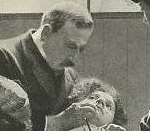 forcible, the work of a grappling prison doctor and assistants. The full-page illustration was entitled:
forcible, the work of a grappling prison doctor and assistants. The full-page illustration was entitled:
"Forcible Feeding Through the
Nose of Women Suffragist Prisoners"
and then pointing out:
"Pronounced as dangerous by many
Leading Members of the Medical Profession..."
It is the story of medical indulgence and state insistence of not recognizing any displays of independence while imprisoned--feeding a woman against her will, a woman prisoner at the hands of what sounds to be cruel warders and an insistent doctor. The woman in question was Lady Contance Lytton (b. 1869, imprisoned in disguise as "Jane Warton") in Walton Goal,
The vote did not come until 1918 with the Representation of the People Act, which in June 1917 passed the House of Commons and which went through the House of Lords in February of the next year, granting full enfranchisement to all women (over the age of thirty. This is about two years before American women were given the right to vote--on August 26, 1920--and 25 years after women won the vote in New Zealand, which again was first on the scene like it has been so many times). Lady Lytton would do badly in prison after this, suffering a heart attack and then a stoke by 1911, and never really recovered--she was half-paralyzed , was hardly robust, and wound up in her grave in 1923, aged 54.
The Story of Lady Constance Lytton:
"I was visited by the Senior Medical
Officer, who asked me how long I had been without food. I said I had
eaten a buttered scone and a banana on Friday about
"He urged me
to take food voluntarily. I told him that was absolutely out of the
question, that when our legislators ceased to resist letting women vote then I
should cease to resist taking food in prison.
"Two of the
guards took hold of my arms, one held my head and one my feet. The doctor
leaned on my knees as he stooped over my chest to get at my mouth. I
shut my mouth and clenched my teeth. He seemed annoyed at my resistance
and he broke into a temper as he plied my teeth with the steel implement.
He dug his instrument down and it pressed fearfully on the gums. The pain
of it was intense and at last I must have given way for he got the gag between
my teeth, when he proceeded to turn it much more than necessary until my jaws
were fastened wide apart, far more than they would go naturally.
"Then he put
down my throat a tube which seemed to me much too wide and was something like
four feet in length. The irritation of the tube was excessive. I
choked the moment it touched my throat until it had got down. Then the
food was poured in quickly; it made me vomit a few seconds after it was down
and the action of my sickness made my body and legs double up, but the guards
instantly pressed back my head and the doctor leaned on my knees. The
horror of it was more than I can describe. I was sick over the doctor and
the guards ...
"When the
doctor had gone out of the cell, I lay quite helpless. The guards were
kind and knelt round to comfort me, but there was nothing to be done. I
had been sick over my hair, all over the wall near my bed, and my clothes
seemed saturated with it, but the guards told me they could not give me a change
that night as the office was shut.
"Before long
I heard the sounds of the forced feeding in the next cell to mine. It was
almost more than I could bear, it was Elsie Howey. When the ghastly
process was over and all quiet, I tapped on the wall and called out at the top
of my voice, which wasn't much just then, "No surrender," and
there came her reply, "No surrender."
-- above taken from "Eyewitness to History" by
John Carey, 1987,
Posted by John F. Ptak in Bad Ideas, Women, History of | Permalink | Comments (0) | TrackBack (0)
My wife Patti Digh is an artist, and though she has great musical and painterly talents the greatest expression of her creative sensibilities is through words. And so I think that it is extraordinary that her childhood pencils have somehow made it here, into their future. They are beautiful monuments to childhood creativity, their bite marks, gouges, scratches and just general wear and tear are testaments to Patti busily producing something from her mind, committing it to paper, back there in her deep past when she was only a couple of thousand days old.
A detail of Patti's crayons, which I have written about elsewhere on this blog:
Patti and I have saved virtually every bit of our daughters' artworks--the really interesting stuff has been collected in one place, and then there's the boxes of other artwork that they'll have to deal with in their future.
And yes a Patti pencil box has also survived.
Posted by John F. Ptak in Women, History of | Permalink | Comments (1) | TrackBack (0)
JF Ptak Science Books Post 1025
There's seems little more appealing to the false-chaste medical interests of 1920 England than helping fainting women, all to the betterment of social relations, clean houses and vibrant sexual partners. The heritage of patriarchal piety's rejection of sensual pleasure that was so common in England and Europe for many hundreds of years filed its way deeply into the 20th century. Suspension of sexual discussion and understanding aside, it was well understood that women's sexual nature was completely repressed unless in response to the pleasure of men. It was a story of submission and subjugation, with all responsibilities for failed masculine sexuality falling to the shoulders of women (as clearly stated in the still-popular Stall's marriage manual, a 19th century piece of rusty thinking still serving as the standard bearer in the early 20th century). The manual is a codex of denial, submission, ignorance, boredom, tiredness, exasperation and triviality so far as sexuality is concerned for women--there is no hint of pride, or of enjoyment.
Urodonol was a product in long use in Europe and England, a quack medicinal of little harm that plagued the hopes of people with aliments elusive to medical detection, especially that of the greatly secret ennui and fatigue in response to sexual relations. It claims to have cured rheumatism, migraine, acidity, gravel, gout, sciatica, arthritis, biliary colic and of course obesity, all taken care of with teaspoons and thimbles. The most that it did perhaps was to not cause any of these aliments. But it did paint a picture of the failing, fainting woman being restored to stature so common to the pages of advertisement in The Illustrated London News (this issue for 5 June 1920). Pre-Urodonol the lady is being assisted by the nurse to the well-pillowed fainting coach--"ahh" she says, her arms outstretched looking for balance, faking a tottering in her high heeled shoes. The coach was a step away.
Urodonal was the cure, as we see Her refreshed and elegant in new hair and hat, rushing to get home to the man who now needn't worry about not being cared for.
Curiously the ad next to this one--same size, same typeface--is for another quack medicine for men whose seed is evidently growing moldy in the bottom of their sowing sack. Globeol addresses the keyword problems for sexual malaise: "debility, overstrain, anaemia, nervous exhaustion" by "conversion into pure, strong, health-giving blood". Lest the use of STRONG BLOOD PURE BLOOD-FORMING HEALTH-GIVING GOOD SOWER be lost there is always the Johnny Appleseed person above, casting about his seed, growing children instantly.
If sexual malaise be, then Urodonol and Globeol is there for some sweet, secret sippings; a little shot here and there will bring the sexes together. Or not.
I might be completely wrong on this but, really, I like the possibility of this weird approach's explanatory power--it doesn't take a philo-shrinkologist to see the conjoined symbolisms in this set of ads and the approach to unmentionable complaints, and that's what I think is exactly going on here.
Posted by John F. Ptak in Medicine, History of, Women, History of | Permalink | Comments (0) | TrackBack (0)
Tags: feminism, history of women, SUbjugation of women, women
JF Ptak Science Books Post 1023
[Part of this site's History of Women series.]
This graph illustrating the history of skirt lengths in the United States is oddly interesting and appealing, a job well done. I like that the graph lines fairly well reveal the amount of leg shown by the rising and lowering hemlines, measuring the height above the ankle from bottom to top.
Now: I offer what I think must be the female record for the most distance between the ankle and the hemline--I reckon it to be about 60 feet.
There are certainly a wide universe of captions for this picture, but for some reason I'm most comfotable with the exposed-leg connection.
Posted by John F. Ptak in Absurdist, Unintentional, Information, Quantitative Display of, Maps/Diagrams of Imagination & Ideas, Women, History of | Permalink | Comments (0) | TrackBack (0)
Tags: design, fashion, Graphical display of data, skirt length
JF Ptak Science Books LLC Post 1015
This is another (number 15 or so) in a series of posts on images from my News Service Photographs of WWI collection. All thousand or so of them were made in the last half of 1918, in the last months of the grueling conflict, and were intended to be used by newspaper and magazines to illustrate stories about the war. An editor would send off a request to one of these agencies for, say, a photograph of marching American nurses, and the agency would send one back (for a fee) along with a caption. There's really no way for me to determine if these photos were ever published, and there is never an attribution for the photographer.
[Another example in this series can be found here. Also if you enter the search term for news service photo in the google site search box you'll get 55 or so returns.]
This is the first installment of women at war--there should be another 35 or so coming soon.
Also I've micromanaged the prints, pulling out a detail from each one of them, a detail of an appealing portrait perhaps difficult to see int he overall original.
For example:
comes from the sweeping woman at right, taking care of some debris in a munitions factory in October 1918, sweeping as the King and Queen of England stroll by on a visit/inspection. I suspect she was instructed to say nothing and to not look up from her work. She doesn't look nervous to me, though--her hands aren't tightly gripped around the broom handle, and her face looks relaxed...
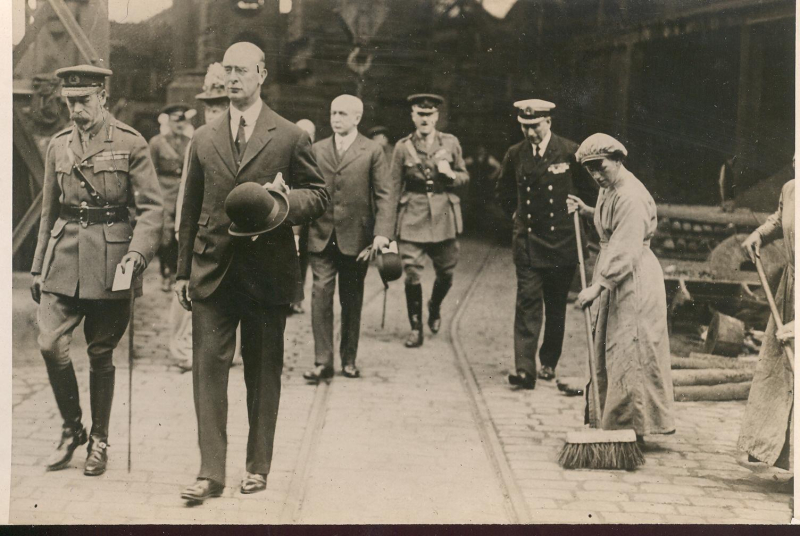
WRAF in track and field exercises, Kent. This is the third-place finisher, running while leaning back, trying to keep everything in place, mouth closed, arms down--pretty good results from such an awkward and highly-mannered style of running. Also, the woman to her right is a dead-ringer for Alan Turing (if you've ever seen the Enigma Man running at track, I think you'd have to agree.)
The great Alan Turing
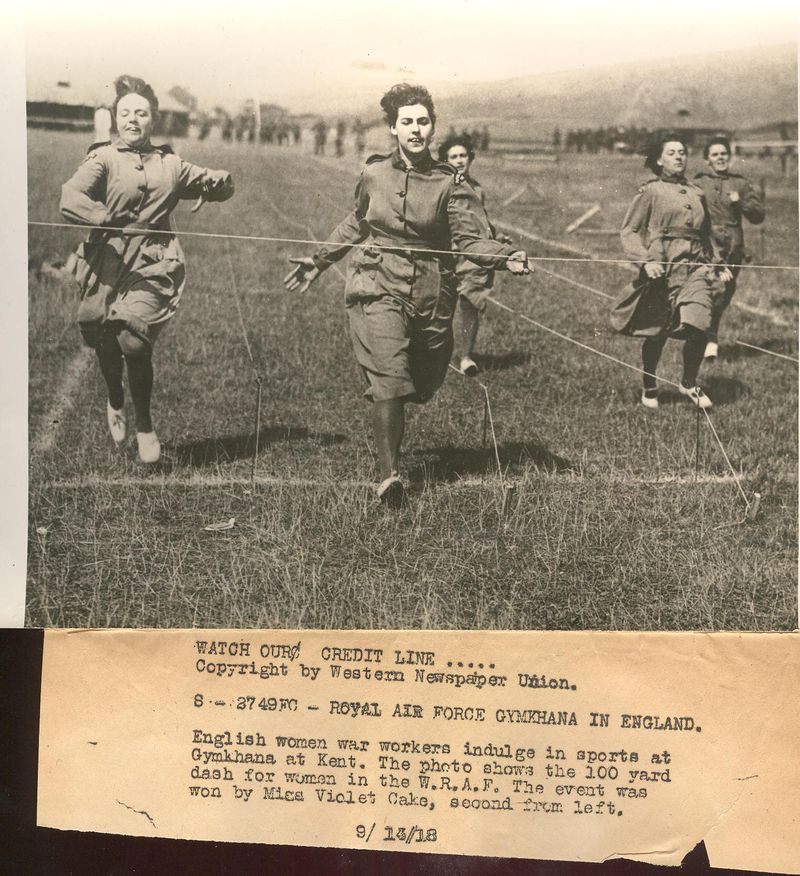
I just liked this woman from the typing/steno pool.
Detail of the image of the Forestry Corps of the Women's Land Army of England, working at cutting telegraph poles on some great-looking draught horses. (The horse on the right--ears back--looks big and unhappy.) I love that this woman is wearing a tie.
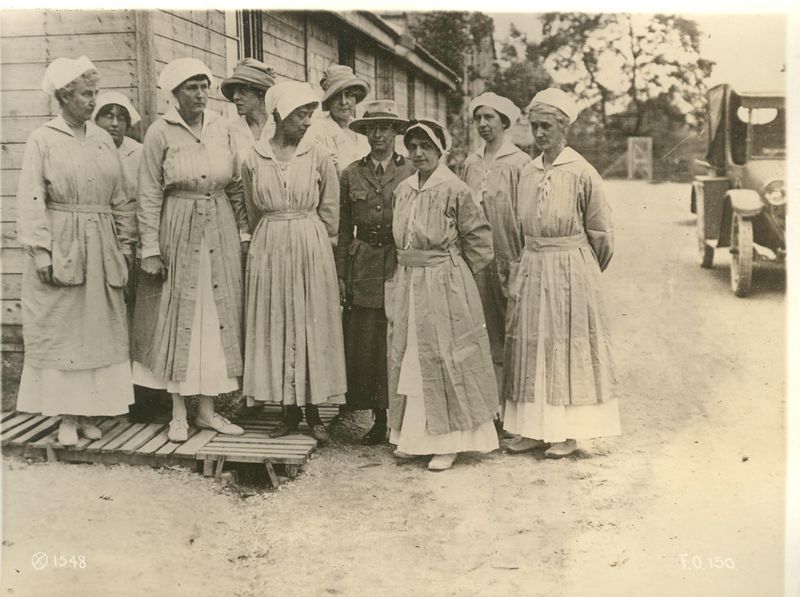
Detail from "Soldiers' children being care for by volunteer nurses, Berlin, June 19, 1919".
Posted by John F. Ptak in Militaria, Women, History of | Permalink | Comments (2) | TrackBack (0)
JF Ptak Science Books LLC
I wanted to collect some of the posts on this blog on this subject as it seems as though I really don't have a category for it in the archives...
What Goes into Making Human Robot Girls



How to Look Smart, or Pretty, but Not Both
http://longstreet.typepad.com/thesciencebookstore/women-history-of/

Missing Pieces of Women: Pope Joan and the Proper Girl of the Ladies Home Journal
How
FDR Made Women (1) Nervous and thus (2) Older. An Appeal to Vote Republican,
1936

The Coming Sex War of 1919
http://longstreet.typepad.com/thesciencebookstore/2010/01/the-coming-sex-war-of-1919.html

Posted by John F. Ptak in Absurdist, Unintentional, Women, History of | Permalink | Comments (0) | TrackBack (0)
JF Ptak Science Books LLC Post 988
In the history of archaic thought it doesn’t take very much at all to reach the uncomfortable bits in the sulfurously tangled history of the subjugation of women. But it is most interesting when you find the points at which the “backward-looking” archaic parts are actually somewhat forward-looking for their time.
Such is the case with this odd and interesting little pamphlet, Women in Men’s Clothing, published by
the Vultee Aircraft Corporation, and published in 1943—it can be simultaneously
awkward as a broken product of its time and oddly, slightly, futuristic (with a grudging and clawing recognition of women as possible equals as members of the work force). Overall the publication looks pretty painful from today's perch, but when you look a little past the winces you can see a little bit of recognition for women in general; at least this is far forward from anything that might've been published slightly before the war.
The pamphlet was intended as a human resources tool for managers and supervisors in an aircraft production facility where women had been sought and recruited to fill the very many vacancies brought on by the war. (Millions of women entered the workforce for the first time between 1942-1945; millions of them exited too once the servicemen returned from active duty to reclaim their jobs.) For most industrial supervisors, the prospect of women in the workforce was not a welcomed one, and many had never before needed to think of such a diversified workplace. This slight publication translated the idea of “women/"wimmin” for these men.
The "translation" of the understanding of women from home to the workforce doesn't go very far to advancing the understanding of women at work--they're pretty much the same (dogmatic, condescending, sexist, domineering).
All of that is pretty well summed up by the first picture in this series--the asterisked "equality" between men and women. I must admit that I don't think I've ever seen this "equals, but" label before, or at least so deep into the century.
And of course "women are Human, too" needs very little comment...as is the case for most of the images in the pamphlet.
Posted by John F. Ptak in Absurdist, Unintentional, Bad Ideas, Blank and Empty Things; A History of, History of the Future, Women, History of | Permalink | Comments (1) | TrackBack (0)
Tags: equal rights, feminism, history of women, sexism, subjugation of women
JF Ptak Science Book LLC Post 941
Having just finished a post here on missing and duplicated-in-outer-space New York Cities, we return to the more grim possibilities of pre-Cold War cityicide.
I haven't seen very many images at all of NYC under attack, and this one from nuclear attack on NYC from Collier's Magazine (1948) is fantastically poignant, showing perhaps three ground-bursts of atomic bombs in Manhattan and Brooklyn. At the time, 1948, the Soviets had just developed their bomb and I think had no way of getting one here. But this didn't speak to the future, and my guiess is that Collier's was just taking it a little easy with the popular reading clientelle. I can't remember now how many weapons would've been targeted at NYC by the mid-1950's, but I know it wasn't a simple dozen.
A lateral view of this sort of explosion in Manhattan was presented in an extraordinary issue of the liberal PM Magazine, issued with a 7 August 1945 date (though I think it came out a few days later). This would have been just a day after the Hiroshima bombing, and the 12 pages of dedicated coverage t the atomic bomb was really quite spectacular. Included is the following small graphic that appeared on page seven which shows what effect the Hiroshima
Seeing the Collier's pictures makes it that much more difficult to think about the idea of Buckminster Fuller that would help rid ourselves of radiation anxiety (which I wrote about earlier, here).
Fuller’s idea is multiple orders of magnitude removed from the
original idea of the arcade, constructing a dome1 to encapsulate NYC
from the East River to the Hudson along 42nd St, and from 64th to 22nd
St: that’s two miles in diameter and, plus a mile high (or about five
Empire State Buildings pile one on top of the other). I’m not so sure
how this would be built, or how things would be heated or cooled, or
what the construction material was for the skin of the dome, or how
people get in and out, or how you deal with heating and cooling, or how
any noxious chemicals are expelled—but Mr. Fuller thought that the
savings alone from snow removal from NYC streets would pay for the dome
in ten years. 
Mr. Fuller also thought that the dome would protect the city (or this part f the city) from radiation fallout. That could be true, assuming that of all the hundreds of nuclear warheads that the Soviets would’ve launched against NYC alone none of them would’ve found their target, except perhaps for the Ridgways or Staten Island, where the shock wave or winds produced by ensuing firestorms would not have disturbed the dome. Of course if a warhead actually came close—or actually hit—the dome, the protection from radiation would be moot.
Another odd and stomach-wrenching image comes from that devilish scamp Eugen Sanger (dead before he was fifty,
1905-1964), a German rocket designer and engineer for the National
Socialists, went to work for the French Air Ministry following the end
of World War Two after doing his all and thankfully falling short for
the Reichsluftfahrtministerium (RLM, or "Reich Aviation Ministry").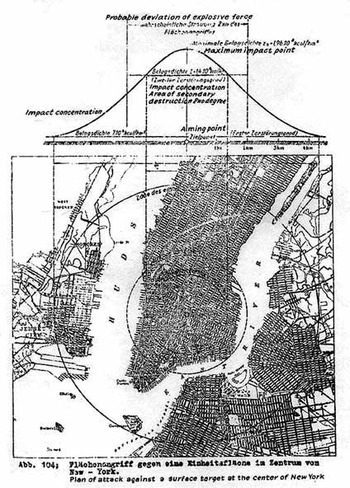
He
worked without rancor there until he was nearly kidnapped by Joe
Stalin—for the purpose I suppose of continuing work on what may have
been his greatest effort, unfulfilled during the war years—the Amerika
Bomber. The Soviets evidently thought that this might come in handy in
1947.
The Sänger Amerika Bomber (or Orbital Bomber, Antipodal Bomber or Atmosphere Skipper) was designed for supersonic, stratospheric flight, and had much more bang for the buck than the V2 (10000 feet/second exhaust velocity, as compared to the later V-2 rocket's 2000 meters/second, 6560 feet/second) and since it was stratospheric had a far greater range, coming in at better than 14,000 miles. The 22,000-pound weapon carried one large 8000-pound free-falling bomb.
Sanger’s idea in the early 1940’s was to get this bomb to around Times Square. And since the Amerika Bomber was a relatively inexpensive weapon compared to the damage it could cause, there was room for producing a lot of them.
Seeing Manhattan in the cross hairs like this is quite sobering, and it is an image that is rarely made.
Another attack on Manhattan depicted here comes from above, way above, Manhattan decimated by a meteorite "shower" of enormous magnitude. The image appears in an article by Hudson Maxim (1853-1927, brother of the 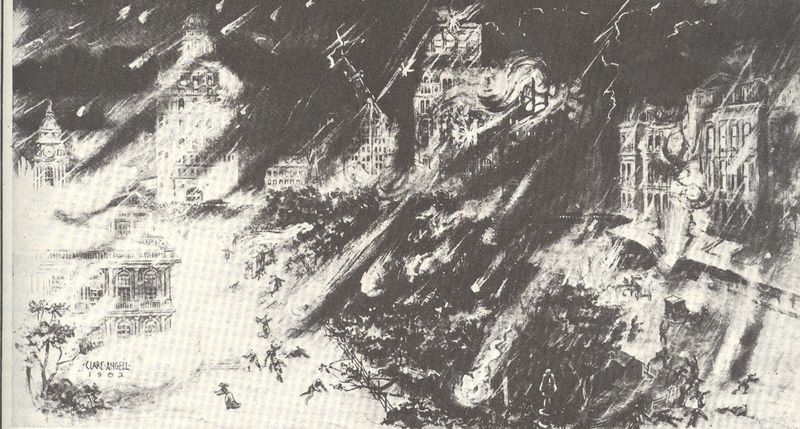 more famous Hiram) "How the World Will End", printed in 1910, and shows dozens of small meteorites striking NYC in the City Hall area.
more famous Hiram) "How the World Will End", printed in 1910, and shows dozens of small meteorites striking NYC in the City Hall area.
The last image comes from 1904 and--when taken out of context--it seems as though Manhattan is in for the worst of it, with a view in front of the Flat Iron Building of an aerial bombardment of women. This is probably one of the few bad things that weren't done with/at women, and would actually predate the first use of explosives being dropped from aircraft. Unfortunately the original, intended image was a poke at crinoline , and featured women being blown up into the air rather than the other way around, though I like my interpretation better.
Notes:
(Source: Buckminster Fuller in Think magazine, vol 34, Jan/Feb 1968. AND of course the lovely work by Alison and Sky Michele Stone, Unbuilt America, McGraw Hill, 1976, pg. 99.)
Posted by John F. Ptak in Absurdist, Unintentional, Architecture and Building, Atomic and Nuclear weapons, Bad Ideas, Women, History of | Permalink | Comments (0) | TrackBack (0)
Tags: Amerika Bomber, Eugen Sanger, New York City
JF Ptak Science Books LLC Post 930
[Continuing the posts What Makes Human Robot Girls, 1941, How to Get a Boy-Date, 1941, and The Missing Pieces of Women, Pope Joan and the Proper Girl]
Following on the tall heals of several posts on mid-1940's social engineering for young women comes this rougey sprite by Dorothy Cocks, Tricks with Make-up. It is one of a long series of quickly-produced pamphlets flung from the presses of the Ladies' Home Journal under the stewardship of Elizabeth Woodward.
There's much to learn about what was expected of the social shell of women in this pamphlet, but what I've focused on is this jewel on page 7: "Which is Your Type: Pretty or Smart?" And that's it: no ground in-between, no space for something else, and evidently no room for being smart AND pretty. Here it is:
The advice to "touch perfume behind your ears and above your upper lip" is a new one to me.
Posted by John F. Ptak in Absurdist, Unintentional, Women, History of | Permalink | Comments (0) | TrackBack (0)
JF Ptak Science Books LLC Post 921
{This continues "The Coming Sex War of 1919")
Theodore J. Goe, the author of “Let’s Protect our Women”, must have been a synesthete, with the ability to smell the future. My copy of this pamphlet used to be the Copyright Deposit copy, and is dated January 18, 1936, and what Mr. Goe was smelling were the winds of the November presidential election; and since he was a Republican—or at least an anti-Rooseveltian—what he smelled was outrageous defeat for his cause.
 Women didn’t rush to aid FDR’s competition in the ’36 race,
when
Women didn’t rush to aid FDR’s competition in the ’36 race,
when
Landon was a decent man who had an interesting post-political career—even so, it’s a good thing that he lost.
JF Ptak Science Books LLC Post 920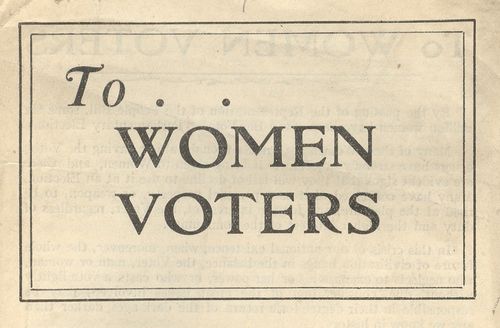
This slight, four-page pamphlet was a flare to the newly enfranchised women of Great Britain1, a very-shakily congratulatory bit with wide, sniffy overtones of vast male superiority. The author takes the intended (female) reader at a very slow, almost-stopped pace about what voting is all about, turning down the rhetoric to explain what a vote “is”. Not only that, but the following as well:
“It seems, therefore, important to give as simply as possible a brief sketch of:
(1) What Politics are. [Politics is the Science of Government.] (2) The Duties of Citizenship. (3) Coalition Government”.
Just because women got the vote (or partial vote: they had top be over thirty years of age and have property or be
married to a man with property; full voting rights devoid of property requirements didn’t come in until 1928) didn’t
mean that they enjoyed a relaxation of their inferior social caste. The social consciousness of the status of women may have been slightly fragmented in 1918/19, but only enough to introduce them to the world of politics as you would a child—at least as far as this pamphlet is concerned2.
But this work comes around a bit, retracting its insulting narrative somewhat by the end of the pamphlet, as what the writer really wanted was to snag a bunch of these women to vote for the Coalition Candidate, Mr. Lloyd George, in the General Election of December 1918. Their votes were definitely wanted, and the need was addressed, if not without a little fear that women would retract themselves and form their won party. The pamphlet states:
"If the Voters are mean and corrupt, they will get what they deserve...There is a movement among women at the present time, especially among those who were most active in working for the Vote, to refuse to join any of the old political Associations, but to form a Women's Party or Federation of Women. Such a step is to be very much regretted, for it will certainly lead to a sort of sex war, men and women being divided into opposite camps, each fighting for their selfish ends."
Assuring women of what a "vote" and "politics" are, and demanding that the priorities of "women's political parties" would lead to a "sex war", the author blandly asks his (!) readers to vote for Lloyd George.
Notes
(I should point out an earlier post that I made about the coming equality of women in voting and lung cancer, "Deathly Equality: Liberty, Lung Cancer and Women's Rights".)
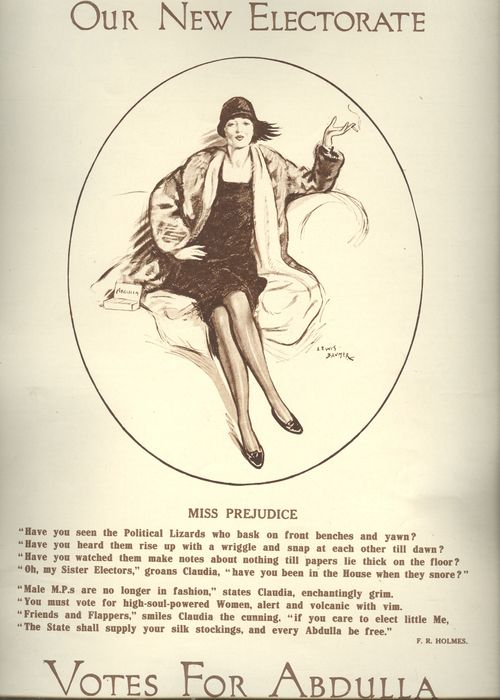
Posted by John F. Ptak in Bad Ideas, Future, History of the, History of the Future, Women, History of | Permalink | Comments (0) | TrackBack (0)
JF Ptak Science Books LLC Post 914
[Continuing the posts "What Makes Human Robot Girls, 1941" and The Missing Pieces of Women, Pope Joan and the Proper Girl]
Do Boys Like You? is
the name-of-the-game for girls, evidently (“set out to make yourself worthy of a boy’s
affection. Just one boy—any boy…”),
brought to you as a part of a long, continuing series by Elizabeth Woodward in
the Ladies’ Home Journal in the early
1940’s. 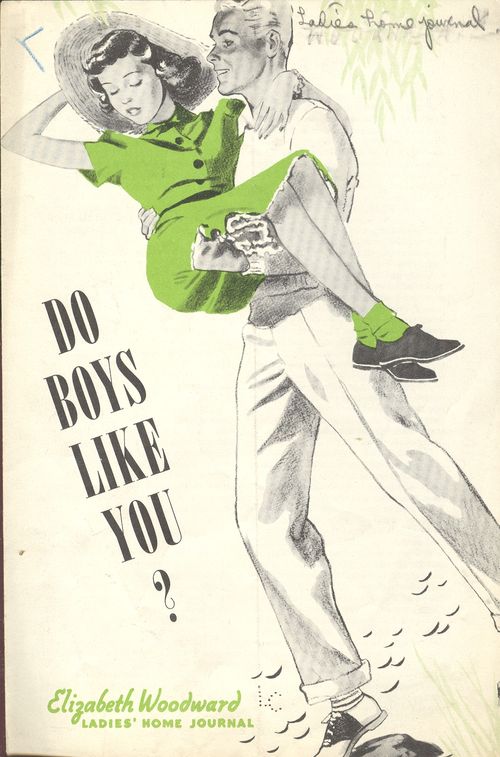
This installment is about getting a boy for a date, and how to make oneself getable and datable and boy-friendly, all while maintaining the thinnest veneer of self-acknowledgment ("be adaptable as a chameleon") as possible while staying true to "yourself". It is a cocktail of overall old-lady sense and deep ruffled bows writ by the hand of gender entrapment and not-so-subtle subjugation. Let’s get to it with some of the more archaeologically-interesting statements of this social-norms-establishing pamphlet:
Paragraph: (Intro):
“Do boys like you, or don’t they? Its as easy as that! Either you have dates and go places with lots of boys, or they don’t pay any attention to you at all.”
Paragraph: “A Female World”
“…the first thing is to find some men.” (Which is odd because “men” is used only one other time beyond this reference—its all boys and nothing but boys.)
“Short of throwing yourself on their (boys’) mercy, see if you can’t wrangle an introduction out of the girls who do know boys…”
“Your parents could invite their friends over for dinner and ask them to bring along their son. And you do a good job on him!” (I’m not sure what that “job” is.)
“They (boys) can’t find you if you’re packed away in a mob of females.”
Paragraph: “A Rank Outsider” (on being the new girl in a community):
“The girls have things under control and they don’t want any interference from you.”
“You might know more than they do, and you just might talk down your pug nose at them.”
“…you’d better get accustomed to traveling alone…”
“Give them every chance to find out that you aren’t high hat, that you like the same things they do, that you aren’t out to sniggle their men away…”
“When they (the girls) accept you, the boys will too…”
Paragraph: “an Old Story”
“(Boys) are so used to looking at you that they think of you as furniture.You’ve got to be new!”
“If you’re fat and pudgy, make yourself lean, sleek and smart.”
Paragraph “Take it Easy”
“…its going to take practice to make boys like you. Take it easy. Set out to make yourself worthy of a boy’s affection. Just one boy—any boy…”
Paragraph “A Few Gentle Hints” (Seems that we’ve gone way beyond this by now.)
“Don’t run around with girls who are dud.”
“Don’t go in pairs with a girl who is overwhelmingly popular…Better pick a girl who will give you an even break.”
“Don’t languish for some local ‘hero’ who is sought after by all the girls in town. He may be good-but he’s far out of reach…”
“Don’t pick on a lad who has never had a date with a girl.”
“Don’t be careless or sloppy when you’re talking with boys…”
“Don’t expect (or even hope) that every boy you meet will ask you for a date.”
And (not quite) lastly, but should’ve been:
“Don’t go around thinking about boys constantly.”
But lastly thus:
“Act as though you are having fun. Be alive, gay and enthusiastic. Be interested in what's going on. Be sweet, tactful, and adaptable as a chameleon. Have definite likes and dislikes, but don’t be so rigid that you are stubborn, opinionated and difficult to get long with. Be carefree, casual, easy, willing to play and fun to play with. And don’t be shy about liking the boys.
THEN THE BOYS WILL LIKE YOU! [Emphasis in the original.]
My poor mother would’ve been reading this…
(Thanks to Jeff Donlan for pointing out that the chap on the cover carrying the girl away has joined the fabric of her skirt to (1) hold onto and steady her and (2) make sure her skirt doesn't fly up and out and is not actually touching her thigh…)
JF Ptak Science Books LLC Post 907
[See the follow-up post "First Thing to Do is to Find Some Men"; How to Get a Boy-date, 1941]
An old friend of mine, Dr. Sam Koslov, was brilliant, accomplished and polymathic, with great senses of wonder, inquisitiveness and humor. He spent many years in research and as a long-time editor at Johns Hopkins APL. He was a delightful and serious man, though one of the projects he worked on sounded much more like squeaky scifi than pure sci. That was Project Pandora, and science fiction it definitely wasn’t—it was an attempt at a form of control over human behavior via low level microwave radiation1.
This
came to mind as I was leading through some very low level, high impact behavior
control exhibited in a series of social engineering pamphlets published by the Ladies’ Home Journal in the early 1940’s. 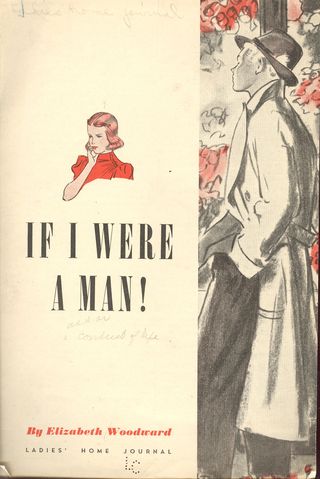 It is heartbreaking, really, to think of people
like my mother reading these things and being inundated by cultural architecture
that left little to the imagination. It
seems so terrifically outrageous in 2010; and of course it makes me wonder
about what things that seem so de rigueur
today will be the Ladies’ Home
Embarrassments of 2050
It is heartbreaking, really, to think of people
like my mother reading these things and being inundated by cultural architecture
that left little to the imagination. It
seems so terrifically outrageous in 2010; and of course it makes me wonder
about what things that seem so de rigueur
today will be the Ladies’ Home
Embarrassments of 2050 .
Granted, nobody's corneas were being shaken loose via this method, but the effect of the sentiments of control in these pamphlets still seem eye-poppingly strangulating. I’ve included only a few examples here, but there are at least a hundred others to choose from.
Perhaps
it was the Date-Rate pamphlet that caused most of my teeth to fall out—it is
sheer and painful, offering virtually nothing to the young women reading it and
practicing its morality play but gender obedience and servility.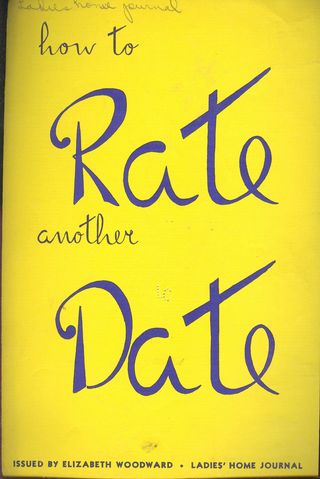
“Did you give him all your attention?” “Did he run things?” “Did you give him a chance to impress you?” “Could you make him laugh?” It isn’t until the final rating question (#25) that we get to something that opened the possibility of a two-way interest in the relationship, but only barely: “Did you find you liked the same things?” Its sad, really.
When I read some of this to my 17-year-old
daughter, she just looked at me with an open mouth and eyebrow furrows: it was simply beyond listening to, for her,
and certainly not anywhere near worthy of a response.
Of course this is just the tip of the tip of the tippity tip of the iceberg on the control of social thought and the keeping of the male-dominated social order, and its only one part of a very wide spectrum of overall codifications, much of which seem pretty much left to history within two generations.
JF Ptak Science Books LLC Post 837 Blog Bookstore
 On of the great innovations in a sea of great things accomplished during the Franklin Roosevelt administrations was the formation of the Farm Security Administration, a division of the government established to help farmers through the devastating Dust Bowl and Great Depression. A subset of the FSA was a photographic unit which was set up to document the progress made by the FSA (and provide, I am sure, for some much-needed good news, a hearts-and-minds campaign). This division was headed by Roy Emerson Stryker, who wound up hiring a collection of dream-team photographers unlike any ever assembled for a single purpose. Esther Bubley, Marjory Collins, Mary Post Wolcott, Arthur Rothstein, Walker Evans, Russell Lee, Jack Delano, Gordon Parks, Charlotte Brooks, John Vachon, Carl Mydans, Dorothea Lange and Ben Shahn were sent out all across the country and wound up with the greatest and most beautiful photographic history ever assembled. There were about 77,000 images made, and I recall reading (somewhere) that the total budget for the Stryker group for the years 1936-19421 was about $100,000, meaning that each completed image cost just over a dollar apiece.
On of the great innovations in a sea of great things accomplished during the Franklin Roosevelt administrations was the formation of the Farm Security Administration, a division of the government established to help farmers through the devastating Dust Bowl and Great Depression. A subset of the FSA was a photographic unit which was set up to document the progress made by the FSA (and provide, I am sure, for some much-needed good news, a hearts-and-minds campaign). This division was headed by Roy Emerson Stryker, who wound up hiring a collection of dream-team photographers unlike any ever assembled for a single purpose. Esther Bubley, Marjory Collins, Mary Post Wolcott, Arthur Rothstein, Walker Evans, Russell Lee, Jack Delano, Gordon Parks, Charlotte Brooks, John Vachon, Carl Mydans, Dorothea Lange and Ben Shahn were sent out all across the country and wound up with the greatest and most beautiful photographic history ever assembled. There were about 77,000 images made, and I recall reading (somewhere) that the total budget for the Stryker group for the years 1936-19421 was about $100,000, meaning that each completed image cost just over a dollar apiece.
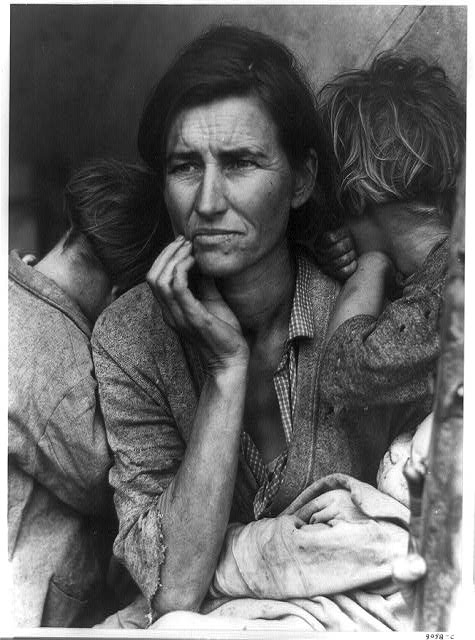 One of the most compelling of all of these images was from a series made by the new-hire Dorothea Lange (1895-1965) in 1936. On the tail end of a month-long road trip she was nearing the end of her day when she spotted a hand-lettered sign reading “Pea-Pickers Camp” by the side of the road near Nipomo, California. She briefly considered stopping but went ahead, and for the next 20 miles of hard road continuously questioned her decision. Unable to shake her better judgment, she turned around and drove back to the turn-off for the camp. Lange drove down the dirt road and found a ramshackle assembly of tents, one of which contained an exhausted mother sitting forlornly with her children, sheltered in a tent fashioned to the rear of the woman’s tireless car. Lange spent only 10 minutes with the woman, making five exposures. She learned that “the crops had frozen, and the woman and children were living on vegetables scavenged from the fields, and the few birds that the children managed to catch. The mother could not leave; she had sold the tires from her car".
One of the most compelling of all of these images was from a series made by the new-hire Dorothea Lange (1895-1965) in 1936. On the tail end of a month-long road trip she was nearing the end of her day when she spotted a hand-lettered sign reading “Pea-Pickers Camp” by the side of the road near Nipomo, California. She briefly considered stopping but went ahead, and for the next 20 miles of hard road continuously questioned her decision. Unable to shake her better judgment, she turned around and drove back to the turn-off for the camp. Lange drove down the dirt road and found a ramshackle assembly of tents, one of which contained an exhausted mother sitting forlornly with her children, sheltered in a tent fashioned to the rear of the woman’s tireless car. Lange spent only 10 minutes with the woman, making five exposures. She learned that “the crops had frozen, and the woman and children were living on vegetables scavenged from the fields, and the few birds that the children managed to catch. The mother could not leave; she had sold the tires from her car".
Her photograph created an American Madonna in her Migrant Mother.
George P. Elliott, writing in the introduction for the Lange retrospective at the Museum of Modern Art (New York), grasped the essence of the image:
"For an artist like Dorothea Lange who does not primarily aim to make photographs that are ends in themselves, the making of a great, perfect, anonymous photograph is a trick of grace, about which she can do little beyond making herself available for that gift of grace".
Lange describes her encounter as follows:
"I saw and approached the hungry and desperate mother, as if drawn by a magnet. I do not remember how I explained my presence or my camera to her, but I do remember she asked me no questions. I made five exposures, working closer and closer from the same direction. I did not ask her name or her history. She told me her age, that she was thirty-two. She said that they had been living on frozen vegetables from the surrounding fields, and birds that the children killed. She had just sold the tires from her car to buy food. There she sat in that lean- to tent with her children huddled around her, and seemed to know that my pictures might help her, and so she helped me. There was a sort of equality about it". (From: Popular Photography, Feb. 1960). Lange's field notes of the images read: "Seven hungry children. Father is native Californian. Destitute in pea pickers’ camp … because of failure of the early pea crop. These people had just sold their tires to buy food."
Roy Emerson Stryker, who was in charge of the photography project (History Section) for the FSA said of this image:
"When Dorothea took that picture, that was the ultimate. She never surpassed it. To me it was the picture of Farm Security. She has all the suffering of mankind in her, but all the perseverance too. A restraint and a strange courage".
NOTES
1. The photographic history unit of the FSA morphed into a propaganda arm for the Office of War Information (OWI) in late 1942.
2. Florence Owens Thompson (1903-1983) is the real name of the Migrant Mother.
3. The Library of Congress files for the series of photos
Posted by John F. Ptak in Photography, history, Women, History of | Permalink | Comments (3) | TrackBack (0)